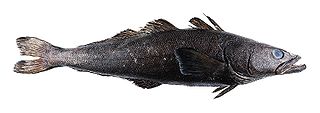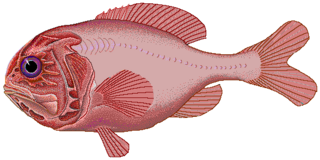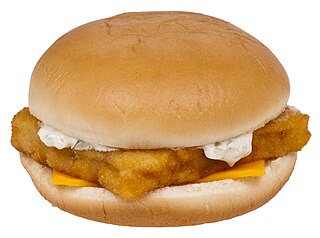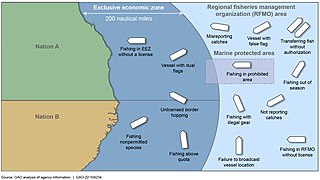
The Merlucciidae are a family of cod-like fish, including most hakes. They are native to cold water in the Atlantic and Pacific Oceans, and typically are found at depths greater than 50 m (160 ft) in subtropical, temperate, sub-Arctic or sub-Antarctic regions.

The Patagonian toothfish is a species of notothen found in cold waters between depths of 45 and 3,850 m in the southern Atlantic, Pacific, and Indian Oceans and Southern Ocean on seamounts and continental shelves around most Subantarctic islands.

Overfishing is the removal of a species of fish from a body of water at a rate greater than that the species can replenish its population naturally, resulting in the species becoming increasingly underpopulated in that area. Overfishing can occur in water bodies of any sizes, such as ponds, wetlands, rivers, lakes or oceans, and can result in resource depletion, reduced biological growth rates and low biomass levels. Sustained overfishing can lead to critical depensation, where the fish population is no longer able to sustain itself. Some forms of overfishing, such as the overfishing of sharks, has led to the upset of entire marine ecosystems. Types of overfishing include: growth overfishing, recruitment overfishing, ecosystem overfishing.

The orange roughy, also known as the red roughy, slimehead and deep sea perch, is a relatively large deep-sea fish belonging to the slimehead family (Trachichthyidae). The UK Marine Conservation Society has categorized orange roughy as "vulnerable to exploitation". It is found in 3 to 9 °C, deep waters of the Western Pacific Ocean, eastern Atlantic Ocean, Indo-Pacific, and in the eastern Pacific off Chile. The orange roughy is notable for its extraordinary lifespan, attaining over 200 years. It is important to commercial deep-trawl fisheries. The fish is a bright, brick-red color, fading to a yellowish-orange after death.

The Marine Stewardship Council (MSC) is a non-profit organization which aims to set standards for sustainable fishing. Fisheries that wish to demonstrate they are well-managed and sustainable compared to the MSC's standards are assessed by a team of Conformity Assessment Bodies (CABs).

The Filet-O-Fish is a fish sandwich sold by the international fast food restaurant chain McDonald's. It was created in 1962 by Lou Groen, a McDonald's franchise owner in Cincinnati, Ohio, in response to falling hamburger sales on Fridays resulting from the Western Christian practice of abstaining from meat on Fridays, which plays an important role in Roman Catholicism, Methodism and Anglicanism. While the fish composition of the sandwich has changed through the years to satisfy taste and address supply shortcomings, the framework of its ingredients have remained constant; a fried breaded fish fillet, a steamed bun, tartar sauce and pasteurized American cheese.
The pink cusk-eel, Genypterus blacodes, is a demersal species of cusk-eel found in the oceans around southern Australia, Chile, Brazil, and around New Zealand except the east coast of Northland, in depths of 22 to 1,000 metres. Their length is up to 200 centimetres, and they live for up to 30 years. Their maximum weight is 25 kilograms.

Illegal, unreported and unregulated fishing (IUU) is an issue around the world. Fishing industry observers believe IUU occurs in most fisheries, and accounts for up to 30% of total catches in some important fisheries.
John West Foods is a United Kingdom-based seafood marketing company established in 1857, and currently owned by Thai Union Group of Thailand. The company produces canned salmon and tuna, as well as mackerel, sardine, herring, brisling, anchovies and shellfish.

The End of the Line: How Overfishing Is Changing the World and What We Eat is a book by journalist Charles Clover about overfishing. It was made into a movie released in 2009 and was re-released with updates in 2017.

The Alaska pollock or walleye pollock is a marine fish species of the cod genus Gadus and family Gadidae. It is a semi-pelagic schooling fish widely distributed in the North Pacific, with largest concentrations found in the eastern Bering Sea.

Sustainable seafood is seafood that is caught or farmed in ways that consider the long-term vitality of harvested species and the well-being of the oceans, as well as the livelihoods of fisheries-dependent communities. It was first promoted through the sustainable seafood movement which began in the 1990s. This operation highlights overfishing and environmentally destructive fishing methods. Through a number of initiatives, the movement has increased awareness and raised concerns over the way our seafood is obtained.

As with other countries, New Zealand’s 200 nautical miles exclusive economic zone gives its fishing industry special fishing rights. It covers 4.1 million square kilometres. This is the sixth largest zone in the world, and is fourteen times the land area of New Zealand.
Sustainable seafood advisory lists and certification are programs aimed at increasing consumer awareness of the environmental impact and sustainability of their seafood purchasing choices.
The Quota Management System (QMS) is a type of individual fishing quota that is used in New Zealand to manage fish stocks.
Seafood in Australia comes from local and international commercial fisheries, aquaculture and recreational anglers. It is an economically important sector, and along with agriculture and forestry contributed $24,744 million to Australia's GDP in year 2007–2008, out of a total GDP of $1,084,146 million. Commercial fisheries in Commonwealth waters are managed by the Australian Fisheries Management Authority, while commercial and recreational fishing in state waters is managed by various state-level agencies.
The fishing industry in England covers the fish processing industry and fishing trawler companies that fish around England.
A fish company is a company which specializes in the processing of fish products. Fish that are processed by a fish company include cod, hake, haddock, tuna, herring, mackerel, salmon and pollock.
Macruronus is a genus of merluccid hakes. Most are found in southern oceans off Argentina, Chile, South Africa, Australia and New Zealand, but M. maderensis is only known from Madeira. Members of this genus reach 1–1.3 m (3.3–4.3 ft) in length depending on the exact species involved.
Merluccius australis, the Southern hake, is a species of fish from the family Merlucciidae, the true hakes. It is found in the southern Pacific and Atlantic Oceans with two disjunct populations, one around southern South America and the other in the waters around New Zealand.













